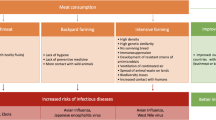Summary
The results of an intensive 12 months study of a number of herds in the migratory and sedentary sectors of the livestock economy of Southern Darfur are recorded.
In almost every production parameter the performance of the former is superior to that of the latter but, overall, production appears to be static or declining. During 1973 the cattle population of the area is estimated to have declined by 7 per cent. Meat production per kilogramme of breeding female was calculated to be 0·057 kg in the migratory sector but only 0·023 kg in the sedentary sector. Calculated calving rates are significantly higher at 65 per cent in the migratory sector than the 40 per cent of the sedentary sector. Deaths in the former sector were only 15 per cent compared with the 35 per cent of the latter. It is concluded that total settlement of the migratory sector is not the answer to the current problem of the livestock sector of Southern Darfur.
Résumé
Les résultats d'une étude intensive sur l'économie du bétail dans le Nord Darfour, qui a demandé douze mois d'observations sur des troupeaux sédentairs et transhumants, sont rapportés.
Pour presque tous les paramètres intéressant la production, les performances du bétail sédentaire sont supérieures à celles du bétail de transhumance, mais dans l'ensemble la production paraît être stable sinon déclinante. Pour 1973, on estime que la population bovine de cette région a diminué de 7 p. 100. La quantité de viande produite par kilogramme de femelle reproductrice est de 0,057 kg chez les animaux d'élevage extensif et seulement de 0,023 pour les animaux sédentaires.
Les moyennes des vêlages sont significativement plus élevées dans le secteur transhumant que dans l'autre, 65 p. 100 contre 40 p. 100 respectivement.
Les morts dans le premier secteur atteignent 15 p. 100 contre 35 p. 100 dans le second.
On conclut que la sédentarisation totale du bétail transhumant ne constitute pas de réponse valable au problème du bétail dans le Sud Darfour.
Resumen
Se hace recuento de los resultados de un estudio económico ntensivo de doce meses de un número de hatos en el sector migratorio y sedentario del Sur de Sudan. En casi todos los parámetros de producción, la productividad de los animales en el sector migratorio es superior a la de los animales en el sector migratorio es superior a la de los animales del sector sedentario; pero en general la producción parece estar estática o en descenso. Durante 1973 se estima que la población de ganado del área ha descendido en un siete por ciento. La producción de carne por kilogramo de hembra en producción se calculó en 0·057 kg en el sector migratorio y de 0·023 kg. en el sector sedentario. El porcentaje de nacimientos es significativamente más alto, 65 por ciento, en el sector migratorio contra un 40 por ciento del sector sedentario. El porcentaje de mortalidad en el primer sector fue del 15 por ciento comparado con el 35 por ciento del sedentario. Se concluye que la inmobilidad del sector migratorio no es la respuesta a los problemas que afronta el sector ganadero del Sur de Darfur.
Similar content being viewed by others
References
Baasher, M. M. (1966). Livestock development in the central rainlands of the Sudan—potential and problems. Proceedings Thirteenth Annual Conference of the Philosophical Society of the Sudan, Khartoum.
Donaldson, L. E. (1963). Where are those calves?Queensland Agricultural Journal,89, 275–279.
FAO (1971). Report of the Sudan Livestock Identification Mission. FAO Investment Centre, Rome.
Hall, H. T. B. (1961). A note on the dressing percentage and percentage of bone of Sudanese cattle.Sudan Journal of Veterinary Science and Animal Husbandry,3, 46–47.
Hunting Technical Services (1972). Livestock Sector Review and Project Identification. Ministry of Planning, Sudan Government, Khartoum.
Mukhtar, A. M. S. (1961). Some observations on the rate of gain, birth and weaning weights of Southern Darfur calves in regard to sex and respective size of dams.Sudan Journal of Veterinary Science and Animal Husbandry,2, 208–211.
Williamson, G. &Payne, W. J. A. (1965).An Introduction to Animal Husbandry in the Tropics, 2nd ed. Longmans, London.
Wilson, R. T. &Clarke, S. E. (1975). Studies on the livestock of Southern Darfur, Sudan. I. The ecology and livestock resources of the area.Tropical Animal Health and Production,7, 167–187.
Rights and permissions
About this article
Cite this article
Wilson, R.T., Clarke, S.E. Studies on the livestock of Southern Darfur, Sudan. Trop Anim Health Prod 8, 47–57 (1976). https://doi.org/10.1007/BF02383365
Accepted:
Issue Date:
DOI: https://doi.org/10.1007/BF02383365




